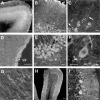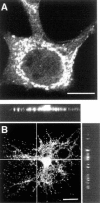The sigma receptor: evolution of the concept in neuropsychopharmacology - PubMed (original) (raw)
The sigma receptor: evolution of the concept in neuropsychopharmacology
T Hayashi et al. Curr Neuropharmacol. 2005 Oct.
Abstract
Although originally proposed as a subtype of opioid receptors, the sigma receptor is now confirmed to be a non-opioid receptor that binds diverse classes of psychotropic drugs. Sigma receptors are subdivided into two subtypes, sigma-1 and sigma-2. The sigma-1 receptor is a 25-kDa protein possessing one putative transmembrane domain and an endoplasmic reticulum retention signal. Sigma-1 receptors are highly expressed in deeper laminae of the cortex, olfactory bulb, nuclei of mesencephalon, hypothalamus, and Purkinje cells in the brain. Sigma-1 receptors are predominantly localized at the endoplasmic reticulum of both neurons and oligodendrocytes. From behavioral studies, sigma-1 receptors were shown to be involved in higher-ordered brain functions including memory and drug dependence. The actions mediated by sigma-1 receptors at the cellular level can be considered either as acute or chronic. The acute actions include the modulation of ion channels (i.e., K+ channel, NMDA receptors, IP3 receptors) and the sigma-1 receptor translocation. Chronic actions of sigma-1 receptors are basically considered to be the result of an up- or down regulation of the sigma-1 receptor itself. For example, the upregulation of sigma-1 receptors per se, even without exogenous ligands, promotes cellular differentiation and reconstitution of lipid microdomains (lipid rafts) in cultured cells. These findings together suggest that sigma-1 receptors might possess a constitutive biological activity, and that sigma-1 receptor ligands might merely work as modulators of the innate activity of this protein. Recent in vitro and in vitro studies strongly point to the possibility that sigma-1 receptors participate in membrane remodeling and cellular differentiation in the nervous system.
Keywords: IP3 receptor; Sigma receptor; differentiation; drug dependence; lipid rafts; oligodendrocyte; potassium channel; sigma-1 receptor.
Figures
Fig. (1)
Protein structure of the sigma-1 receptor.
Fig. (2)
Brain distribution of sigma-1 receptors. Sigma-1 receptors in adult rat brains were visualized by immunofluorescence using anti-sigma-1 receptor antibodies and Alexa480-conjugated secondary antibodies. Images were captured by fluorescence confocal microscopy. (A) Olfactory bulb, (B-C) parietal cortex. Arrows indicate dendrites. (D) Subventricular zone. LV: lateral ventricle. (E-F) Hippocampus CA3, (G) corpus callosum, (H-I) cerebellum. Scale bars in A, B, D, and H are 100 ;Cm, others are 20 ;m.
Fig. (3)
Cellular distribution of sigma-1 receptors. Sigma-1 receptors are detected by immunofluorescence as described in Fig. (2). (a) Cellular distribution of sigma-1 receptors in a NG-108 cell. Sigma-1 receptors are highly clustered and localized at the perinuclear region in NG-108 cells. (b) Cellular distribution of sigma-1 receptors in a mature oligodendrocyte from the rat brain. Z-dimensional images are captured along horizontal and vertical white lines, respectively. Orthogonal sections indicate that clusters of sigma-1 receptors are located in cytoplasm of the myelin sheet. Scale bars=10 ;m.
Similar articles
- The potential role of sigma-1 receptors in lipid transport and lipid raft reconstitution in the brain: implication for drug abuse.
Hayashi T, Su TP. Hayashi T, et al. Life Sci. 2005 Aug 19;77(14):1612-24. doi: 10.1016/j.lfs.2005.05.009. Life Sci. 2005. PMID: 16002098 Review. - Sigma receptors [σRs]: biology in normal and diseased states.
Rousseaux CG, Greene SF. Rousseaux CG, et al. J Recept Signal Transduct Res. 2016 Aug;36(4):327-388. doi: 10.3109/10799893.2015.1015737. Epub 2015 Jun 9. J Recept Signal Transduct Res. 2016. PMID: 26056947 Free PMC article. - Sigma-1 receptor ligands: potential in the treatment of neuropsychiatric disorders.
Hayashi T, Su TP. Hayashi T, et al. CNS Drugs. 2004;18(5):269-84. doi: 10.2165/00023210-200418050-00001. CNS Drugs. 2004. PMID: 15089113 Review. - K+ channel modulation in rodent neurohypophysial nerve terminals by sigma receptors and not by dopamine receptors.
Wilke RA, Lupardus PJ, Grandy DK, Rubinstein M, Low MJ, Jackson MB. Wilke RA, et al. J Physiol. 1999 Jun 1;517 ( Pt 2)(Pt 2):391-406. doi: 10.1111/j.1469-7793.1999.00391.x. J Physiol. 1999. PMID: 10332090 Free PMC article.
Cited by
- Sigma-1 receptor agonist, (+)-pentazocine, is neuroprotective in a Brown Norway rat microbead model of glaucoma.
Mysona BA, Zhao J, De Greef O, Beisel A, Patel PA, Berman L, Smith SB, Bollinger K. Mysona BA, et al. Exp Eye Res. 2023 Jan;226:109308. doi: 10.1016/j.exer.2022.109308. Epub 2022 Nov 15. Exp Eye Res. 2023. PMID: 36400283 Free PMC article. - Cocaine-Mediated Autophagy in Astrocytes Involves Sigma 1 Receptor, PI3K, mTOR, Atg5/7, Beclin-1 and Induces Type II Programed Cell Death.
Cao L, Walker MP, Vaidya NK, Fu M, Kumar S, Kumar A. Cao L, et al. Mol Neurobiol. 2016 Sep;53(7):4417-30. doi: 10.1007/s12035-015-9377-x. Epub 2015 Aug 5. Mol Neurobiol. 2016. PMID: 26243186 Free PMC article. - Sigma-1 Receptor Signaling: In Search of New Therapeutic Alternatives for Cardiovascular and Renal Diseases.
Munguia-Galaviz FJ, Miranda-Diaz AG, Cardenas-Sosa MA, Echavarria R. Munguia-Galaviz FJ, et al. Int J Mol Sci. 2023 Jan 19;24(3):1997. doi: 10.3390/ijms24031997. Int J Mol Sci. 2023. PMID: 36768323 Free PMC article. Review. - The Pharmacology of Visual Hallucinations in Synucleinopathies.
Russo M, Carrarini C, Dono F, Rispoli MG, Di Pietro M, Di Stefano V, Ferri L, Bonanni L, Sensi SL, Onofrj M. Russo M, et al. Front Pharmacol. 2019 Dec 9;10:1379. doi: 10.3389/fphar.2019.01379. eCollection 2019. Front Pharmacol. 2019. PMID: 31920635 Free PMC article. Review. - High-throughput screening discovers antifibrotic properties of haloperidol by hindering myofibroblast activation.
Rehman M, Vodret S, Braga L, Guarnaccia C, Celsi F, Rossetti G, Martinelli V, Battini T, Long C, Vukusic K, Kocijan T, Collesi C, Ring N, Skoko N, Giacca M, Del Sal G, Confalonieri M, Raspa M, Marcello A, Myers MP, Crovella S, Carloni P, Zacchigna S. Rehman M, et al. JCI Insight. 2019 Apr 18;4(8):e123987. doi: 10.1172/jci.insight.123987. eCollection 2019 Apr 18. JCI Insight. 2019. PMID: 30996132 Free PMC article.
References
- Alonso G, Phan V, Guillemain I, Saunier M, Legrand A, Anoal M, Maurice T. Immunocytochemical localization of the sigma-1 receptor in the adult rat central nervous system. Neuroscience. 97:155–70. - PubMed
- Aydar E, Palmer CP, Djamgoz MB. Sigma receptors and cancer: possible involvement of ion channels. Cancer Res. 2004;64:5029–5035. - PubMed
- Aydar E, Palmer CP, Klyachko VA, Klyachko VA, Jackson MB. The sigma receptor as a ligand-regulated auxiliary potassium channel subunit. Neuron. 2002;34:399–410. - PubMed
LinkOut - more resources
Full Text Sources
Other Literature Sources


